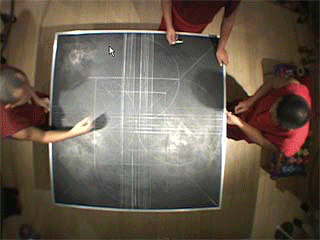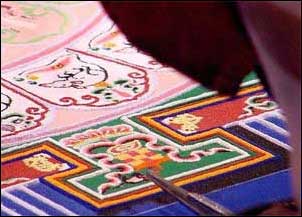I saw a link to this series of photographs, depicting a group of monks working on a sand mandala, on the Kircher Society blog last week. While I’m not a huge fan of monks or sand-painting, I am a fan of large-scale, glacially-paced art projects and behind-the-scenes documentation. Clearly, the fusion of the two via stop-motion animation is among my favorite things ever (see here).
These photographs were practically SCREAMING to be turned into an animation of some sort, so I felt it was my duty to download them and whip up a stop-motion animated gif.
Here it is (2.8 Megs, takes a while to load).

Shortly after doing this, I found that the creation of a strikingly similar Mandala had been animated here. This one is available as a quicktime movie, and features significantly more frames, at a significantly lower resolution. Compromises!
Shortly after finding that video, I found another one, from Rutgers University. This one is the best of the bunch – lots of frames AND lots of resolution (wmv here). Skip about ten minutes in to get to the construction.
If you just CAN’T get enough Monk-made-mandala action, here are some nice detail photos of yet another mandala-in-progress.
If you’ve watched any of these through to the end, you:ll have noticed that after finishing, the monks waste no time in wiping away their work. What’s the point? I wondered too, so I consulted the wikipedia entry on Mandalas, which offers the following:
“To symbolize impermanence (a central teaching of Buddhism), after days or weeks of creating the intricate pattern, the sand is brushed together and is usually placed in a body of running water to spread the blessings of the Mandala.”
Awesome.
Those thirsting for even more detail on the process of sand-mandala construction can consult this site, which is teeming with procedural detail. On the construction:
“Before a monk is permitted to work on constructing a mandala he must undergo a long period of technical artistic training and memorization, learning how to draw all the various symbols and studying related philosophical concepts. At the Namgyal monastery (the personal monastery of the Dalai lama), for example, this period is three years.”
“In the early stages of painting, the monks sit on the outer part of the unpainted mandala base, always facing the center. For larger sized Mandalas, when the mandala is about halfway completed, the monks then stand on the floor, bending forward to apply the colors.”
“Traditionally, the mandala is divided into four quadrants and one monk is assigned to each. At the point where the monks stand to apply the colors, an assistant joins each of the four. Working co- operatively, the assistants help by filling in areas of color while the primary four monks outline the other details.”
“The monks memorize each detail of the mandala as part of their monastery’s training program. It is important to note that the mandala is explicitly based on the Scriptural texts. At the end of each work session, the monks dedicate any artistic or spiritual merit accumulated from this activity to the benefit of others. This practice prevails in the execution of all ritual arts.”
“There is good reason for the extreme degree of care and attention that the monks put into their work: they are actually imparting the Buddha’s teachings. Since the mandala contains instructions by the Buddha for attaining enlightenment, the purity of their motivation and the perfection of their work allows viewers the maximum benefit.”
“Generally, each monk keeps to his quadrant while painting the square palace. When they are painting the concentric circles, they work in tandem, moving all around the mandala. They wait until an entire cyclic phase or layer is completed before moving outward together. This ensures that balance is maintained, and that no quadrant of the mandala grows faster than another.”
“The preparation of a mandala is an artistic endeavor, but at the same time it is an act of worship. In this form of worship concepts and form are created in which the deepest intuitions are crystallized and expressed as spiritual art. The design, which is usually meditated upon, is a continuum of spatial experiences, the essence of which precedes its existence, which means that the concept precedes the form.”
